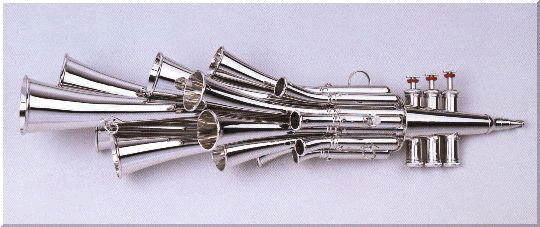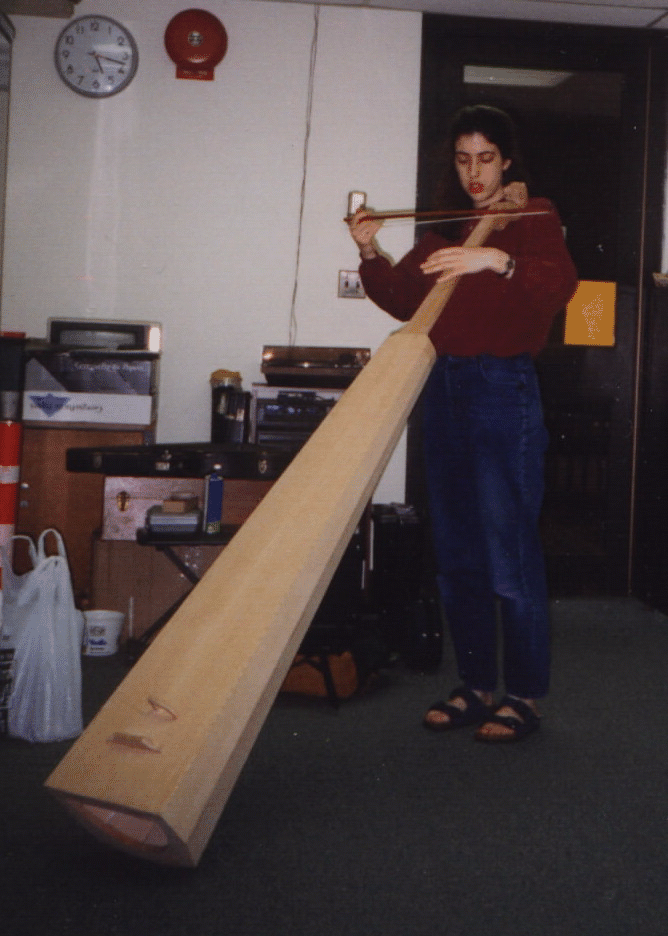According to some of the members of Tanzwut (Dancing Rage), the name of the band was chosen as it was originally used during the Black Death plague pandemic of the fourteenth century, and was also known as "Tanzwahn" and "Tanzplage". It was a way to celebrate life in the face of impending doom as the plague was sweeping its way through Europe. "Dancing Fury" or "Dancing Rage" was a manifestation of fear, grief, joy, madness, anger and all of the emotional extremes to which people can be driven in such desperate circumstances. A way to cope, to be sure! As Castus, a multi-instrumentalist and a founding member has said, this is an appropriate term for the current world situation. Castus: "There happened a story in the year 1351. Musicians came to town with bagpipes and drums while the plague raged and told the people that everything was senseless with the inevitable death close at hand, so lets all have a blast of a party. And this movement was called Tanzwut (Fury Dance). We felt the name just right for the turn of the millennium."
However, the sound and the goals of their two projects (Corvus Corax & Tanzwut) differ. While Tanzwut do use medieval instruments such as Schalmaien and Drumscheit (more on that below), they mix these sounds with techno beats (most of the percussion is electronic) and hard-edged guitars. Actually, one of the great things about this band is that their music is impossible to categorize. Yes, there is the extensive use of Dudelsack (bagpipes), but to pigeon-hole Tanzwut as a "Celtic" band would be highly inaccurate as this is one of the most ancient of all instruments and is not limited to the Celtic sound by any means. As Teufel (the lead singer) has stated, and I quote,
"It is neither Rock'n Roll, nor Techno, nor Drum'n Bass. So what is it? Nobody knows what it is. All we can say is, it is Tanzwut. It is something never heard before and we really want to create an absolutely new style with the bagpipes and all the other stuff we play. We already succeeded in that with our music of the Middle Ages. We really started our own style and in the meantime hundreds of bands show up which play exactly the same. With Tanzwut we want to achieve that sometime in the future the whole world dances to us and recognizes our sound while we in reverse work on something completely new again".
Tanzwut consists of five (or, at times, six) musicians, the aforementioned Teufel (Lead Vocals), Brandan (Lead Guitar, Bagpipes), Castus [Hurdy-Gurdy, Schalmeien, Bagpipes, Drumscheit, Sister (percussion), Vocals], Wim (Bagpipes, Schalmeien), Koll A (Bagpipes, Schalmeien), Tec (Keyboards, Programming).
Schalmeien, known in English as "shawm" and in French as "la chalémie" is a reed instrument of Oriental origin that was adapted by medieval European musicians, here are two versions of this instrument, which is still common to German folk music:


According to Castus, Drumscheit is: "An instrument of the Middle Ages which is also called Marina Trombona. The nuns in the convent used it to imitate the deep voices of the monks. We felt it suits us well because it is a crazy instrument. It is the first distorter of all, it is hard to explain it without seeing it and consists in parts of a wooden piece which gets struck by a string and sounds totally crazy like rrrghhh!"
Here is a photo of Katie playing Marina Trombona:

Labyrinth Der Sinne is comprised of thirteen tracks, all of which are highly unconventional and, in fact, unique entities in and of themselves. I will mention those that I have enjoyed the most, that is just my opinion, you may see it differently. The album opens with the track "Tanzwut", appropriately enough, which was originally recorded by Corvus Corax. This is a completely new take on the old version, it starts off with what sounds like the roar of a motorcycle engine and proceeds from that point. What follows is a very catchy, infectious Eastern (Turkish?) sort of melodic thread throughout much of the song that makes it difficult for the listener to stay still, one's legs just start moving of their own accord and before one knows it, one finds oneself gyrating wildly across the living room. There is a very ironic, sarcastic ambiance to this song, with Teufel posing as a medieval cleric, and to judge from his authoritative stance- one of high standing - who sternly admonishes the dancing populace to cease and desist as they are risking eternal damnation through their frivolous actions. "Satans Werk der Tanz!" he proclaims. (Satan's work is the dance.) Of course, at the time, dancing was considered to be a great sin by the all-powerful Catholic Church and anyone indulging in a such an activity would bring on the wrath of the authorities. Unfortunately, this stance was by no means limited to the Catholic clergy of the Middle Ages, but was also espoused by the English and American Puritans and at the present day, by Islamic hard-liners. If people enjoy moving their bodies to music, experience their sensuality through bodies, minds and spirits, they cannot be easily controlled and manipulated and as such, present a threat to the powers that be. "Verwirren, verdammen, verführen!" is the resounding cry. (Confused, damned and seduced we may be, but who is to decide what we choose to experience on our sojourn here in the physical world?)
The second song, titled "Ekstase" is a passionate, intense celebration of sexuality, with the agony being recognised as the integral part of the ecstasy. "Es ist die Leidenschaft die meine Leiden schafft" -this phrase is a play on the words "Leidenschaft" which means "passion" and "Leiden" - sorrows, pains. This song will leave you breathless!
The next track, "Lügner", opens with the solemn wail of the bagpipes, but it soon becomes obvious that this song is a wry and acerbic tale of a relationship gone wrong. "Liar" is the refrain. Another song where one has to sing along, there is no help for that.
"Bitte Bitte" (Please, please) - a great S&M tune, originally by the German band Die Ärzte, ardent and tragic (and possibly humourous?). "Please, please, let me be your slave" is the message here. I used to think that the best song ever written on the subject of sadomasochism was "Feuerräder" by Rammstein, but both "Ekstase" and "Bitte Bitte" are right up there with Rammstein's oeuvre.
"Das Labyrinth", the song that follows, is probably my very favourite of this album, free-flowing like a mountain stream, its icy current pure and clear. The techno sound of this track is complemented by the intelligence of the lyrics and the great (as throughout the album) vocals. The refrain goes: "Im Labyrinth der Sinne - In den Wirren Deiner Seele bist Du ganz allein - Im Labyrinth der Sinne - Nur wer beflügelt wird sich des Rätsels Lösung sein"
or, in English: "In the labyrinth of the senses- in the confusion of your soul you're all alone
In the labyrinth of the senses-only in the flight through it lies solution to the riddle"
"Niemals Ohne Dich" (Never Without you) is a haunting, sad, beautiful love song, or at least as close to a love song that Tanzwut come, and is probably the most Gothic of the album: longing and devotion, sweetness and pain all play a part here:
"Ich hör' Dein Lachen
Ich spür' Deine Haut
Ich renne in die Nacht
Ich shrei' nach Dir
Verlier' den Verstand
Wie ein tollwütiges Tier"
"I hear your laughter
I feel (sense) your skin
I run in the night,
I cry for you
Having lost my reason
Like a rabid beast"
"Dämmerung" (Twilight) - Dark, Gothic, tongue-in-cheek, highly danceable, though the lyrics do say that:
"Ich tanze nicht an Deinen Ketten
Und ich werd Dein Knecht nicht sein" -
"I do not dance in your chains
And I will not be your servant"
"Gigolo" (self-explanatory) - Funny, silly, all about a man whose goal in life is "to please women", perfect blend of Medieval and Industrial.
"Ikarus"- exquisite , magickal, the allegorical story of Ikarus and his quest for the skies. "Fly with me when you can trust me, glide with me gently through the warm air, what is left of us is nothing but a thing". A slow build-up with this song but it does take off, have no doubt!
"Götterfunken" (Sparks of the Gods) - this is, of course, the famous piece by Ludwig van Beethoven, known in English as "Ode To Joy". The original was inspired by the immortal poem by Friedrich Schiller, but Tanzwut have their own interpretation. These lyrics are much darker, include passages of the monologue of Mephistopheles from "Faust" by Goethe and provide an interesting contrast to Schiller's masterpiece. If you'd like to compare, follow this link to the German and English verses of Schiller:Ode To Joy It is amazing of how well the classical and the industrial music components of Tanzwut's track are welded together into one seamless entity.
This is the final track, as it has to be, because there nothing left to be said after that! A very fitting conclusion to a terrific album, with its superlative musicianship, clever lyrics, great sardonic delivery , (especially on "Lügner" and "Gigolo") witty and wicked.
